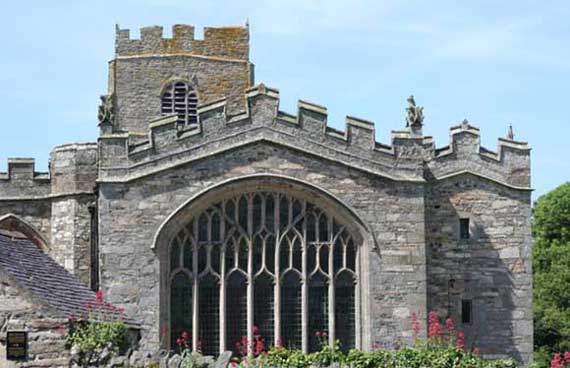A brief history of Clynnog
Fawr
Clynnog Fawr, often simply called Clynnog, is a village
on the north coast of the Llyn peninsula in Gwynedd,
north-west Wales.
Clynnog Fawr lies
on the A499 road between Caernarfon and Pwllheli.
It had a population of 130
in 1991. The main feature of the village is the
church, dedicated to Saint Beuno, which is much larger
than
would be expected in a village of Clynnog's size.
The site is that of a Celtic monastery
founded by Beuno in the early 7th century. It
developed into an important foundation and some Welsh
law
manuscripts specify that the Abbot of Clynnog was
entitled to
a seat at the court of the king of Gwynedd.

Image: St. Beuno's Church, Clynnog Fawr.
The
church is recorded as being burnt in 978 by the
Vikings and later burnt again by the Normans. By the
end of the 15th century it was a collegiate church,
one
of only six in Wales. The church was an important
stopping place for pilgrims heading for Bardsey
Island and contains Cyff
Beuno, an ancient wooden
chest
hollowed out of a single piece of ash and used
to
keep alms (money or goods contributed to the
poor) donated by the pilgrims. 'Maen Beuno' or
Beuno's Stone has markings reputed to
be those
of Beuno's fingers. Outside in the churchyard there
is a sundial dated between the late 10th century
and the early 12th century.
Clynnog is strategically sited at the northern end
of a pass connecting the northern and southern coasts
of the Lleyn peninsula, and the area has been the site
of a number of battles, including the Battle of Bron
yr Erw in 1075 when Gruffudd ap Cynan's first bid to
become king of Gwynedd was defeated by Trahaearn ap
Caradog and the Battle of Bryn Derwin in 1255 when
Llywelyn the Last defeated his brothers Owain and Dafydd
to become sole ruler of Gwynedd.
Other famous people from Clynnog include Morus
Clynnog and Saint John Jones; both prominent Welsh Catholics
in the 16th century. |